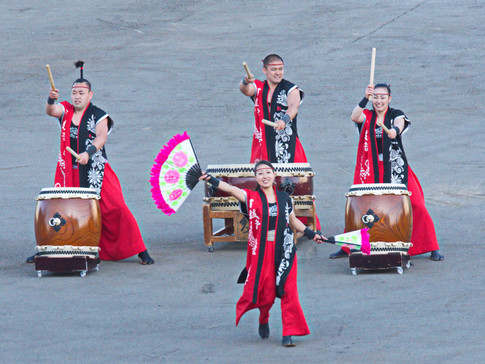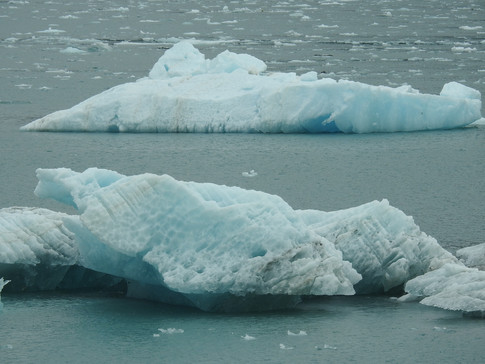NORTH PACIFIC CRUISE
- J & J Cosgrove
- Oct 29, 2019
- 6 min read
Updated: Apr 18, 2020

On May 5, 2019, 16 Victoria birders boarded the
Norwegian Jewel for our trip home to Vancouver. The path of the cruise was from Yokohama, north to the Japanese island of Hokkaido, north (two days at sea) to the Russian town of Petropavlovsk and then east across the north Pacific and Bering Sea (four days at sea) to Seward, Alaska. There would be three other stops in Alaska (Juneau, Icy Strait Point and Ketchikan) and a visit to the Hubbard Glacier before heading down the Inside Passage to Vancouver. The whole trip would be 15 days.
Some of our companions were very skilled birders who were looking for the opportunity to add some pelagic birds to their life lists, some were avid birders, some were avid photographers and some were fairly novice birders who were looking forward to learning about the pelagic birds as well as improving their birding skills.
Below is an excellent map of our transpacific journey with highlights, courtesy of Rob Gowan, one of our fellow birders.

We left Yokohama to the beat of some Taiko drums on the dock and a very pale Mount Fuji in the distance. We birded until dark as we travelled up the east coast of Japan’s main island but we did not see many birds that night. We did document Laysan Albatross, Black-footed Albatross, Short-tailed Albatross as well as Short-tailed, Sooty and Streaked Shearwaters on our first full day at sea. Some in the group had their first WOW moment of the trip with an estimated 90,000 birds in one group.
Click on the photos to see larger images and /or hover over the photos for text
The next morning had some birders on deck at dawn as we approached the island of Hokkaido and our first port of call, Otaru. Many of us had signed up for a shore excursion that turned out to be very disappointing. We spent most of our time standing in line waiting for the ropeway (gondola lift) to take us up and down Mt. Tengu. The second part of the tour was the old home of a wealthy Japanese family. Jim and Mark decided to forego that portion and explored the surrounding area and did pick up some new land birds such as the Black Kite and Chestnut-cheeked Starling. Jeannie and Jan toured the old Japanese home (no interior photos allowed).
Leaving Japan, we spent two full days at sea as we moved north to the port town of Petropavlovsk on the Kamchatka Peninsula of Russia (players of the board game RISK will know where Kamchatka is located). Dawn found us in the midst of the largest flock of shearwaters you could imagine. A one-minute count through a scope yielded 200 birds. We saw many of the same pelagic birds that we had seen near Japan but we added Northern Fulmar, Vega Gull and both Leach’s and Fork-tailed Storm Petrels to the list. One particular bird of interest was a Barn Swallow that crash landed on the deck at the feet of some of our birders. The bird was exhausted and obviously lost. It spent several minutes on the deck, too tired to move, before it flew a short distance to some of the ship’s superstructure. Eventually, it moved out of sight and we did not see it again.
In Russia, customs presented a bit of a hassle to get us off the ship in time to meet a personal tour that one of the birders had been able to arrange. Once on land, a van took us to a boat which took us off on a five-hour trip across Avacha Bay, where we visited several very rich bird sites. Highlights included four Steller’s Sea Eagles, Tufted Puffins by the hundreds, Thick-billed Murre, Red-faced Cormorant and tens of thousands of Blacklegged Kittiwakes. While drifting quietly near the nesting pinnacles of the kittiwakes and murres, the boat crew fed us a very nice lunch followed by a feast of freshly caught and cooked snow crab. What a fantastic afternoon!
Although the seas were rough in places (3–4 meters), only our tour guide, from Russia, was afflicted by mal de mer. He was an interesting shade of green before he disappeared below decks and was not seen again until we were back in the harbour. Well fed, and very happy with the many lifers documented on this trip, in magnificent scenery, we returned to the Norwegian Jewel for our night departure to Seward to the east.

Jeannie and Jan had opted to do a land tour while in Petropavlovsk (named after Vitus Bering’s ships, Peter and Paul), so they saw the interior of a Russian Orthodox Church with all its golden splendor, a local natural history museum (Kamchatka Regional United Museum) and the only mall in town, anchored by a large fish market. The city is rather bleak with uninteresting grey apartment blocks and crumbling paved roads. Two separate tour guides spoke about the feeling of inequity as money from the large fishing fleet is sent to Moscow and any money returning to the community is controlled by the military. Volcanoes loom up from the city and ring the Avacha Bay, which is an important military submarine port on the east coast for Russia.
For the next four days (including two Mother’s Days as we crossed the International Date Line and the Bering Sea), we lined the railings from dawn to dusk and documented the birds we saw. This was a special time as land was so far away and at times we were travelling along the continental shelf. Jaegers, albatross, fulmars, murres, petrels, auklets, phalaropes, puffins, and murrelets were all documented, and again some were present in very large numbers, while others such as Parakeet Auklets were only seen once or twice. It was frustrating trying to take good shots of the birds but many times they were only visible in the scopes or flying away from this large hulking vessel we were traveling on.
Our arrival in Seward, Alaska, brought us back to many of the birds that we knew well, but there were still a few new ones left for the less experienced birders, including
Arctic Tern and Horned Puffin. For those of you who would like to see some of the northern birds and are on an Alaska cruise, then think about taking a boat cruise with Major Marine Tours in Seward. Some great scenery from their boat, and we also saw Mountain Goat, Black Bear, Dall’s Porpoise, Humpback Whale, and Sea Otter.
On our way to Juneau, we stopped to see the Hubbard Glacier but it was overcast and very chilly so not great photos taken.
Since we had been to Juneau in 2013, we elected to wander the streets and find a coffee bar with Wi-Fi – internet connections on the cruise ship are very expensive. We checked out a used book store and some of the tourist shops before returning to the ship for lunch and some reading time in the sunshine.
Before leaving home, we had purchased a birding trip at Icy Strait Point, a new cruise ship port just outside the little village of Hoonah. Eight of us loaded up a van and visited 4 sites for a few hours with Icy Strait Birding Tours. We lucked into seeing 2 Grizzly bears (known as Brown Bears in Alaska), a number of Black-tailed Deer and 26 species of birds.
Landing at Ketchikan gave us the opportunity to do some land birding rather than booking onto a ship tour. As we passed a flowing river, we both commented that it looked like a likely spot to see an American Dipper – sure enough, we found an adult with a chick demanding to be fed. Jeannie took the time to visit the Southeast Alaska Discovery Centre, a small but excellent museum in downtown Ketchikan.
While the focus of our transpacific cruise was the pelagic birds, we did see and document some of the mammals we came across, including Sperm Whale, Common Dolphin, Cuvier’s Beaked Whale, Minke Whale, Humpback Whale, Orca and Dall’s Porpoise. For those of you thinking about doing this trip in the future, then think about doing the September trip from Vancouver to Yokohama. In this direction, dawn is an hour later on the 5 time-changes rather than an hour earlier, each day. Getting up at 0400 one morning and then 0300 the next morning, etc. was a challenge. Of course, going in the fall will get you a different slate of birds and earlier sunsets.
All in all, it was a great adventure and a wonderful way to go birding with friends. For more details you can check out Ann Nightingale’s blog of the trip at http://nightingaleadventures.blogspot.com. Several of our comrades have also posted their labeled photos to Flickr, including Rob Gowan at
NEXT BLOG: Summer 2019


















































































































































Comments